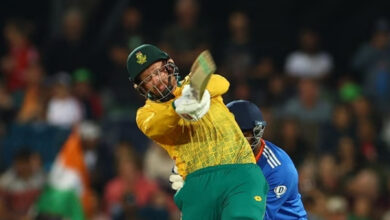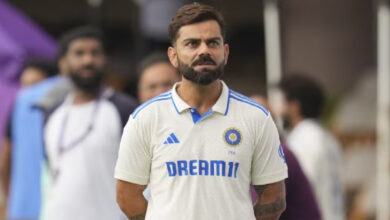IND vs AUS: Why Ashwin out bowled Nathan Lyon

IND vs AUS: Rohit Sharma summed up the craft of Ravi Ashwin candidly: “He looks a different bowler every time he plays Test cricket.” The statement should not be misconstrued as the off-spinner’s streak of experimentalism, his tendency to bowl with different actions, or his penchant for variations. He was simply referring to how Ashwin displays a new layer to his art in every Test, how he keeps evolving, how in a sense he is still a student of the game, even after collecting 457 Tests wickets. He is already a glittering diamond, but he continues to polish himself so that he shines brighter. “You see him, he is getting better and better every time you see him.”
India’s Ravichandran Ashwin bowls a delivery during the third day of the first Test. (AP Photo)
Therein lies the soul of Ashwin’s success too—his astonishing hunger to pick new shades of the game, to master new tricks, to invent new methods, his mind forever browsing to pick new variations. He picked carrom ball from a guy playing tennis-ball in the neighbourhood; he then grasped the reverse carrom from Sachithra Senanayake; in between nuanced the slider and top-spinner, would experiment with his seam and bowl seam-up, would occasionally bowl leg-spin, more as a statement when India were obsessed with wr-spin in white-ball cricket. So much so that he is cricket’s equivalent of the Ulysses, in a perennial voyage to new shores of wisdom. There perhaps is nothing he can’t do—ask him to bowl left-arm spin, he would perhaps bowl with the left-arm too.
It’s this dexterity the reason behind him out-bowling Nathan Lyon in Nagpur. As successful an off-spinner as Lyon is, he is not as multi-dimensional as Ashwin is. On the slow-turner, Lyon’s biggest enemy was his lack of pace. He would flight the ball, purchase drift, drop and turn. But at his pace, and with the quality of Indian batsmen, they could either drag themselves back and play with the turn or judge the flight and defend on the front-foot. Lyon realised it too, but when he looked to bowl flatter, he lost his sting and bite.
On the other hand, Ashwin is better skilled at sizing up the pace that works on a particular pitch and then modulating it accordingly. “Having that idea on what you need to bowl on certain kinds of pitches is very difficult, but Ashwin has that,” Sharma says the obvious.
“The reason he is able to extract from the pitches is because of the skill sets that he has. He is a very studious guy and likes to understand his game and take it to the next level. That is what he is and if you see him he is getting better and
better as you see him every time,” says Rohit.
On the first morning he took his time to understand the nature of the pitch. He didn’t settle into the groove instantly, but as the day wore on, he discovered his rhyme and rhythm. This was no surface for beguiling batsmen with extravagant turn, but rather use the big-turning ball as a decoy. This was more of a stump-to-stump line wicket, where bowled and lbw would be chief modes of dismissals where his slider and top-spinners would be more effective, where he had to bowl like his peers Ravindra Jadeja and Axar Patel for wickets. So he would lay the trap with expansive off-breaks, those that turned and gripped, before the flatter, quicker ones wreaked havoc.
There were exceptions like Usman Khawaja, whose old vulnerabilities against spin Ashwin would rip open, but more often than not, the more prosaic of skills brought him the wickets. In him dwells an art as well as a craftsman. Few other off-spinners have fused art and science as effectively as Ashwin has. There, of course, is the legendary Muttiah Muralitharan but he was more art than science. There were Graeme Swann and Harbhajan Singh, who too were artful, but to a lesser degree than Murali. But none could marry science into art as scientifically or artically as Ashwin has. Perhaps, it was all a product of his generation, of someone who had bred in the pre-IPL era having to practice his craft in the IPL-age.
On Saturday, he produced a condensed version of his art, a short story compared to a novel. Rather, Australia’s batsmen did not let him. Sometimes, it seemed that he just needed to turn up and bowl in a particular way. Toss up a few balls and then slip in a flatter and faster one. Just rinse and repeat, preventing him from displaying his full range of skills. There was no stage for laying elaborate snares.
Yet, Ashwin brought theatre. He would keep rejigging his field, station them in non-conventional positions and induce them batsmen into believing that he is trying to do something earth-shatteringly different. Like when David Warner was batting, he placed what could be called a fly leg-gully. When Alex Carey was in a reverse-sweeping spree, he made first slip, gully, short backward point, if you call it that and short third man almost in a parallel line. And then he speared in a full, fast ball that trapped him leg-before. That was as elaborate as Ashwin got on Saturday. And he indeed has the capacity to look like a different bowler.







